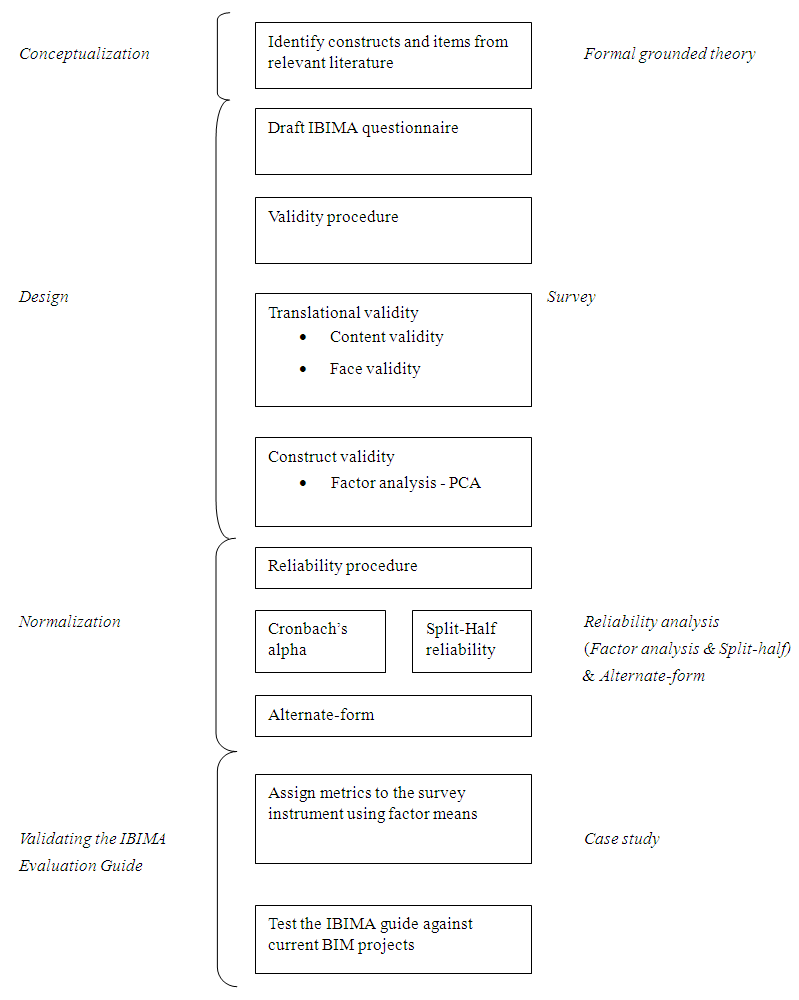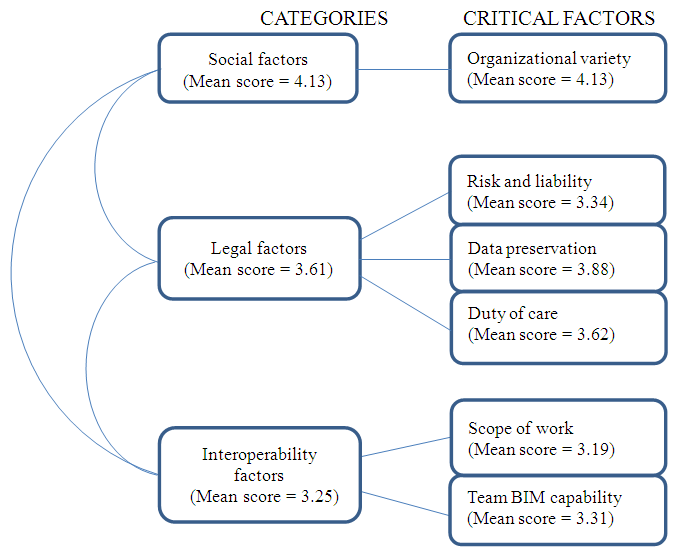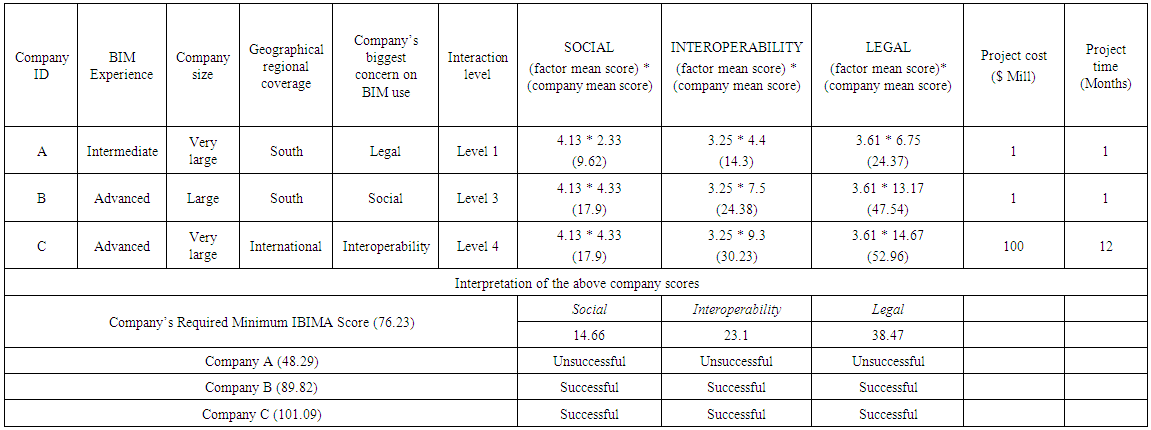-
Paper Information
- Next Paper
- Previous Paper
- Paper Submission
-
Journal Information
- About This Journal
- Editorial Board
- Current Issue
- Archive
- Author Guidelines
- Contact Us
International Journal of Construction Engineering and Management
p-ISSN: 2326-1080 e-ISSN: 2326-1102
2017; 6(3): 78-86
doi:10.5923/j.ijcem.20170603.02

Interorganizational Building Information Modeling (IBIM) Utilization Assessment Guide
Rehema J. Monko1, Charles W. Berryman2, Carol J. Friedland2
1Ardhi University, Dar es Salaam, Tanzania
2Louisiana State University, Baton Rouge, Louisiana, USA
Correspondence to: Rehema J. Monko, Ardhi University, Dar es Salaam, Tanzania.
| Email: |  |
Copyright © 2017 Scientific & Academic Publishing. All Rights Reserved.
This work is licensed under the Creative Commons Attribution International License (CC BY).
http://creativecommons.org/licenses/by/4.0/

Interorganizational collaboration and systemic change promise best realization of Building Information Modeling (BIM) benefits but a commonly accepted guide for evaluating its effectiveness has not been established. This creates a general misunderstanding in prioritizing decision choices confronting BIM users. The purpose of this study was to validate a more complete guide for evaluating interorganizational BIM (IBIM) adoptability. Key measures for the evaluation guide were identified through grounded theory, and further examined through a survey methodology. Six critical factors; organizational variety, team BIM capability, duty of care, risk and liabilities, scope of work, and data preservation, formed the final instrument. This instrument was tested against three case studies of recent BIM projects among the US contractors. Maximum score was determined by multiplying the highest Likert- scale (5) by factor mean scores. The percentage variance explained by the instrument was multiplied by the maximum score to determine the threshold minimum for a company to be successful. Results were consistent with the survey findings, which further validated the instrument as an efficient measure for evaluating IBIM adoptability.
Keywords: Interorganizational BIM, Collaboration, Systemic Change, Evaluation Guide
Cite this paper: Rehema J. Monko, Charles W. Berryman, Carol J. Friedland, Interorganizational Building Information Modeling (IBIM) Utilization Assessment Guide, International Journal of Construction Engineering and Management , Vol. 6 No. 3, 2017, pp. 78-86. doi: 10.5923/j.ijcem.20170603.02.
Article Outline
1. Introduction
- Interorganizational collaboration and systemic change promise best realization of Building Information Modeling (BIM) benefits but a commonly accepted guide for evaluating its effectiveness has not been established. Pre-existing ineffective collaborative strategies is one of the reasons the construction industry has not adopted BIM to the fullest extent (Homayouni, et al., 2010). BIM has been cited in the literature as a promising technology that improves projects performance through increased efficiency (Azhar, et al., 2008; Becerik-Gerber & Rice, 2010; Becerik & Pollalis, 2006; Khemlani, 2007; Neelamkavil, 2009; Suermann & Issa, 2009; Woo, 2006; Yan & Damian, 2008). The industry is being challenged by the inability to fully utilize BIM technology that has the potential to increase efficiency of projects and, in turn, improve the industry’s declining productivity (Dyer, et al., 2012). Contractors, in particular, have been reported to lag behind architects and engineers in sharing BIM generated data (Gilligan & Kunz, 2007; Mutai, 2009; Suermann & Issa, 2009). Effective sharing of BIM generated data across organizations is referred to as interorganizational BIM - IBIM (Fox & Hietanen, 2007). In IBIM, various stakeholders interact when BIM technology is utilized on projects, to effectively implement activities interdependent beyond organizational boundaries. However, such interdependency of activities contradicts the industry’ competitive and fragmented work environment. This has proven difficult to adopt BIM to the fullest extent. Most literature calls for extensive collaboration with downstream project stakeholders to offer opportunities for sharing valuable input at early stages of BIM projects (Khanzode, et al., 2006).Various approaches have been utilized, including motivating critical mass adoption, as well as identifying significant influential factors to guide BIM adoption process (Khanzode, et al., 2006; Mutai, 2009). Successful case studies to the adoption of BIM have been reported along with various challenges faced in practice (Becerik-Gerber & Rice, 2010; Suermann & Issa, 2009). Despite the efforts, most researchers agree that the industry has not best realized the benefits of BIM as a result of interorganizational interactivity challenges. Literature suggests, as BIM users focus on better management of the identified general influential factors, improvements will occur in effective interorganizational collaboration and systemic change. To date, there has been no systematic attempt to organize and synthesize the various sets of critical factors for collaboration and systemic change nor have a more complete evaluation guide been proposed. Even though there are long term accepted measures for general technological adoption such as technology-organization-environment (TOE) framework (Tornatzky & Fleischer, 1990), these are particularly focused on a company/organizational level. The extant literature lacks a clear consensus on interorganizational measures related to BIM adoption. Moreover, variations among interorganizational BIM studies and between the studies and the TOE factors, both in terms of categorizing and contextualizing the factors, suggest the TOE framework inadequately address the interorganizational context. In this present study the development and validation of an evaluation guide for interorganizational BIM adoptability (IBIMA) that is essential to assessing effectiveness of collaborative strategies and systemic change as practiced by BIM users is presented.
2. Methodology
- The development and validation of the IBIMA evaluation guide presented in this study involved various methods (Figure 1.1). Ethical clearance for conducting this research was obtained from the Institutional Review Board (IRB) of Louisiana State University (LSU); IRB Approval #8345. Consent was sought from the study participants, in the form of a clearly written explanation of the aims and objectives of the study, prior to answering questions. The methodology approach is summarised next.
 | Figure 1.1. Process of Validating and Testing the IBIMA Evaluation Guide |
 | Figure 1.2. Extending the Technology-Organization-Environment Framework for Interorganizational BIM Adoption |
 | Table 1. Respondents’ characteristics |
 | Figure 1.3. Critical Factors for Interorganizational Collaboration and Systemic Change in BIM Adoption |
 | Figure 1.4. Split-Half Reliability Statistics |
3. Validating the Interorganizational BIM Adoptability (IBIMA) Evaluation Guide
- In this specific objective, the study demonstrates utilization of the proposed evaluation guide that includes a comprehensive set of six critical factors for interorganizational collaboration and systemic change in BIM adoption. The identified factors are literature-based, and have been examined for reliability analysis through a survey methodology. The evaluation guide was further validated through empirical research, utilizing quantitative data from three most recent BIM projects.Case StudyThree companies were provided with an IBIMA evaluation guide to assess the evaluation guide based on their most recent BIM projects. The respondents were asked to rate their companies’ success on BIM use, based on each of the measurement items. The evaluation guide was measured using a five-point Likert-type scale with anchors ranging from 1 = “very low” to 5 = “very high”. To protect their identity, the three companies are referred to as company A, B, and C. The three companies’ projects were considered as being similar enough to offer a rational comparison. The companies’ revenue in million US dollars were 2,200 (A), 2,002 (B), and 1,300 (C). Companies A and B offered mostly general contracting services, while company C offered mostly design/build services.The maximum IBIMA scale score (i.e. mean scores for each factor multiplied by the highest possible Likert scale score a company could get) for the six factors was 107.35 points. A threshold minimum for determining a company’s success or failure on IBIMA was calculated by multiplying the maximum score by the total amount of variance accounted (71.089%). Specific minimum scores for each factor’s ration contribution to the IBIMA scale was also calculated the same way. This meant that the company’s total score must, at the very least, meet the percentage rate of the total variance accounted by the scale, to be considered successful on IBIMA. Using this approach also helped to recommend specific areas that need improvement, where a company attained scores above the threshold but lower scores on either of the specific factors. A summary of this explanation is provided next, in the form of equations. S = social, I = interoperability, and L = legal, factors.
 From the outlined equations, the minimum score that a company must attain from the three categories, to be considered successful on IBIMA are: 14.66 points (Social), 23.1 points (Interoperability) and 38.47 points (Legal), adding up to 76.2 points. Table 1.2 summarizes results of the IBIMA scores for the three projects.
From the outlined equations, the minimum score that a company must attain from the three categories, to be considered successful on IBIMA are: 14.66 points (Social), 23.1 points (Interoperability) and 38.47 points (Legal), adding up to 76.2 points. Table 1.2 summarizes results of the IBIMA scores for the three projects. | Table 1.2. IBIMA Results of Three BIM Projects |
4. Discussion
- The identified critical measures provided a reliable guide for evaluating the effectiveness of interorganizational interaction in BIM projects. The utilization of the evaluation guide was quantitatively demonstrated using the data collected from three companies among the US contractors. The three projects were considered similar enough to provide a logical comparison (Table 1.2). Thirty six (36) companies that voluntarily provided their contacts during the initial survey were contacted. A request was sent for information related to their most recent BIM projects. However, only three companies responded with complete information. The three case study results shade light on specific areas that have the potential to maximize BIM adoption.Companies A and B both implemented similar BIM projects, in terms of cost ($1 million) and time (1 month). The two companies also operated in the same geographical region (South) and had implemented more than 26 BIM projects, at the time of the study. However, their scores on collaborative (social, interoperability, legal) factors varied significantly. As indicated (Table 1.2), company A scored below the required minimum (unsuccessful) on all the three factors, whereas company B scored above the required minimum (successful) on all the three factors. Company A had an intermediate level of BIM experience, while interacting at level 1. Meanwhile, company B had an advanced level of BIM experience, while interacting at level 3. Company B was successful (scoring above the required minimum) on all the three factors while company A was not. While the two companies differ in terms of BIM experience and the level of interaction, a larger sample is necessary to conclude the impact of the two on the factor scores.While companies B and C were both successful on the factor scores, they still indicated specific concerns with regard to the collaborative factors. Further, it is worth noting that their biggest concerns were significantly different; that is, company B (social) and company C (interoperability). Meanwhile, they both differed from company A (legal) that was unsuccessful on all scores of the collaborative factors. These findings suggest that the three collaborative (social, interoperability, and legal) factors are equally influential to the adoption of BIM at an interorganizational level. The IBIMA evaluation guide, comprising the six critical factors (presented as challenges /inhibitors on the left) and specific item measures (presented as strategic measures/enablers on the right) is presented in Figure 1.5.
 | Figure 1.5. Evaluation Guide for Interorganizational BIM Adoptability |
5. Conclusions – Interorganizational BIM Adoptability (IBIMA) Evaluation Guide
- Different sets of organizational and interorganizational BIM requirements have been offered by different authors. However, no previously published research has developed a comprehensive set of requirements or critical factors that spans the literature. The present research offers a set of six critical factors for collaboration and systemic change, synthesized from various authors. Extant literature on BIM provides little guidance on how to interactively evaluate the proposed critical factors at an interorganizational level. This study successfully developed an instrument that can be used to evaluate interorganizational interactivity to maximize BIM adoption. The measures proposed were empirically based, and shown to be reliable and valid. The reliability coefficients (alphas) ranged from .920 to .923. Split-half reliability test (.709) and Pearson correlation test (.354) also indicated the instrument is reliable. Further, a systematic literature review, through grounded theory, and refinement of the survey by a panel of experts, helped ensure that the measures have the content validity. The correlation coefficients (≥ 0.5) further offered strong evidence of criterion-related validity. The proposed evaluation guide for IBIMA permits managers to obtain a better understanding of the level of interaction in practice. It allows researchers to proceed with the task of developing and testing theories of effective interorganizational collaboration and systemic change in a fragmented and competitive work environment. Managers can use this guide to evaluate their companies’ interactivity level in practice. These measurements can help decision makers identify those areas with the highest potential to maximize BIM benefits. Also, comparisons of different organizations or divisions can be made to help prioritize interactivity practices. The findings presented in this study are encouraging but a great deal of further research remains to be done towards proposing a standard instrument for evaluating IBIMA across disciplines. Future research could replicate the empirical work reported here to corroborate these results. In addition, future studies could involve more items, and larger, more broadly based samples. It is expected that the findings of this study will provide momentum for future research aimed at gaining a better understanding of the collaboration and systemic change necessary to effectively adopt BIM. Overtime, future research will further validate the present findings toward a standard evaluation guide for interorganizational collaboration and systemic change necessary to adopt BIM to the fullest extent.
 Abstract
Abstract Reference
Reference Full-Text PDF
Full-Text PDF Full-text HTML
Full-text HTML